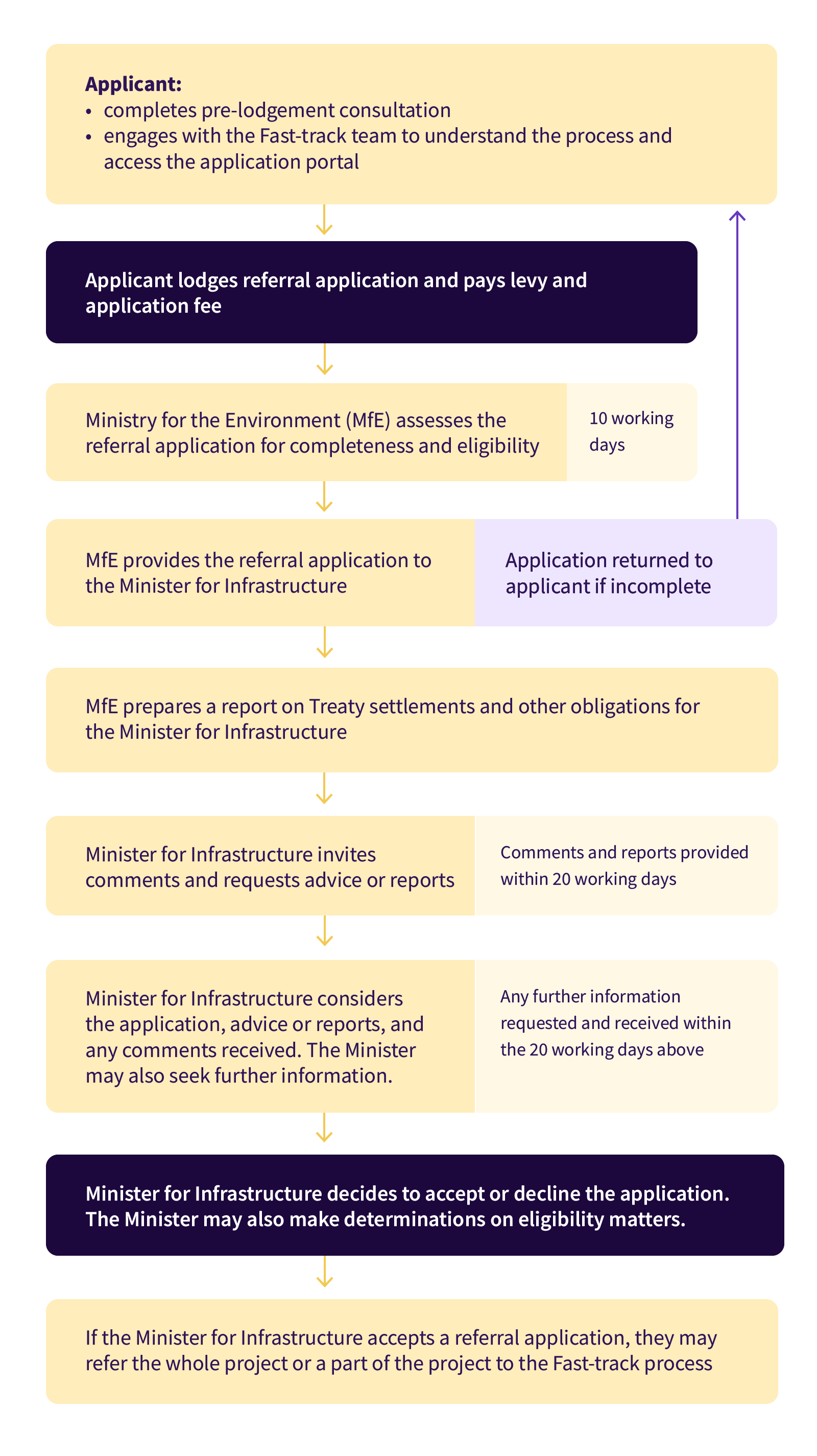Info: Fast-track team offline 25 December 2025 to 4 January 2026
The contact centre closes at midday on 24 December. The application portal and this website remain available throughout the break.
Info: Fast-track Approvals Amendment Act 2025 brings process and timing changes
The changes provide for Government Policy Statements, Ministerial directions, changes to consultation and timeframes, and more. Some changes took effect on 17 December 2025; the rest apply from 31 March 2026.
Fast-track Approvals Amendment Act 2025 – NZ Legislation website
Before you apply
You need to understand whether your project is eligible, the scope of the approvals you need, and how much the process will cost. You need to complete pre-lodgement consultation and gather the information for your application.
1. Understand whether your project is eligible and fits the criteria for referral
Any person can apply to have projects of regional or national significance considered for Fast-track approval.
The Fast-track Approvals Act 2024 (the Act) describes the process, including what projects are eligible and how referral decisions are made.
The Act defines some activities as ineligible activities, for example an activity that would occur in a customary marine title area and has not been agreed to in writing by the customary marine title group.
Meaning of ineligible activity – Fast-track Approvals Act 2024 – New Zealand Legislation website
The Minister for Infrastructure decides whether to accept projects for referral to the Fast-track. There are specified criteria for assessing a referral application. For example, the Minister may consider whether a project will increase the supply of housing, address housing needs, or contribute to a well-functioning urban environment.
Decision on referral application – Fast-track Approvals Act 2024 – New Zealand Legislation website
If the Minister decides to accept a project for referral to the Fast-track pathway, the applicant can lodge a substantive application. The Minister, in their decision to accept a project for referral, may specify certain restrictions on the project or requirements in relation to a substantive application.
Government policy statements
Government Policy Statements can be issued that set out the Government’s policies on the regional or national benefits of certain types of infrastructure or development projects.
If a Government Policy Statement is relevant to your application, you should link your proposal to its objectives and characteristics. Provide evidence and focus on long-term benefits at regional or national scale.
Government policy statements and Ministerial directions
2. Understand which approvals your project will need
Depending on your project’s areas or sectors of activity, you may need one or more other approvals as part of the Fast-track process in addition to a resource consent or a certificate of compliance. For example, you may need a concession from the Department of Conservation Te Papa Atawhai, an archaeological authority from Heritage New Zealand Pouhere Taonga, or a mining permit from New Zealand Petroleum and Minerals.
3. Understand the fees and charges you’ll need to pay
As part of the application process, we will email an invoice for the levy and the application fee to the finance email address you nominated in the Application Portal. The levy and application fee help to recover the cost of the process. The levy is a fixed fee for each type of application. The application fee is also a fixed amount depending on the kind of application, and is applied towards the costs of the application that you will need to cover.
These payments must be made before your application is considered to be lodged.
More detail: Fees, charges and cost recovery
4. Complete pre-lodgement consultation
You need to consult with various organisations before applying for referral. These depend on the location and project activities. They include the relevant local authorities; the relevant administering agencies; any relevant iwi authorities, hapū, and Treaty settlement entities; and others.
5. Gather the information you’ll need
All referral applications must be submitted using the digital form provided in the Fast-track application portal. The document below provides guidance on the information required in your application.
Referral application form guidance (PDF, 1.6 MB)
Contact the Fast-track team with any questions about the process. Advice from the Fast-track team is subject to cost recovery. The Fast-track team will help you access the application portal.
Writing and submitting your referral application
All referral applications must be submitted using the digital form provided in the Fast-track application portal.
The Fast-track team will provide you with access to the portal during the pre-application process.
Once you have access to the portal, you can complete the applicant details and the relevant form for your application and submit them using the portal. The Fast-track team will acknowledge your application.
Fast-track application portal user guide – creating a new referral application (PDF, 1.6MB)
The referral process after you apply
The Ministry for the Environment assesses referral applications and provides advice to the Minister for Infrastructure to inform his decisions on referral applications. This involves the following steps.
The Ministry assesses the referral application for completeness and eligibility. The Ministry either provides the application to the Minister for Infrastructure, or the application will be returned to the applicant if it is incomplete. If an incomplete application is relodged at a later date, it will be treated as a new referral application. Any new application could be subject to additional costs.
The Ministry prepares a report on Treaty settlements and other obligations for each complete project application.
The Ministry then provides this information to the Minister for Infrastructure.
The Minister for Infrastructure decides whether the project should be referred to the substantive stage of the Fast-track process. This involves the following steps.
The Minister receives the complete application, invites comments, and requests advice or reports.
The Minister considers the application, advice or reports, and any comments received. The Minister may also seek further information.
The Minister considers any relevant Government Policy Statement.
The Minister decides to accept or decline the application, and may make determinations on eligibility matters.
If the Minister accepts a referral application, they may refer the whole project or a part of the project to the Fast-track process.
In addition to supporting the Minister for Infrastructure, the Ministry is responsible for advising other parties who may exercise powers, functions and duties under the Act.
What happens after the referral decision
If your project is referred, you can make a substantive application.
The substantive application must be made within 2 years of the referral, or any other deadline set by the Minister for Infrastructure.
More detail: Substantive application for resource consents and other approvals
If your project is not referred, you can apply for referral again. This is considered a new application, subject to fees and charges.
Diagram: Process steps and timing

Diagram showing key steps and timings in the Fast-track referral process
